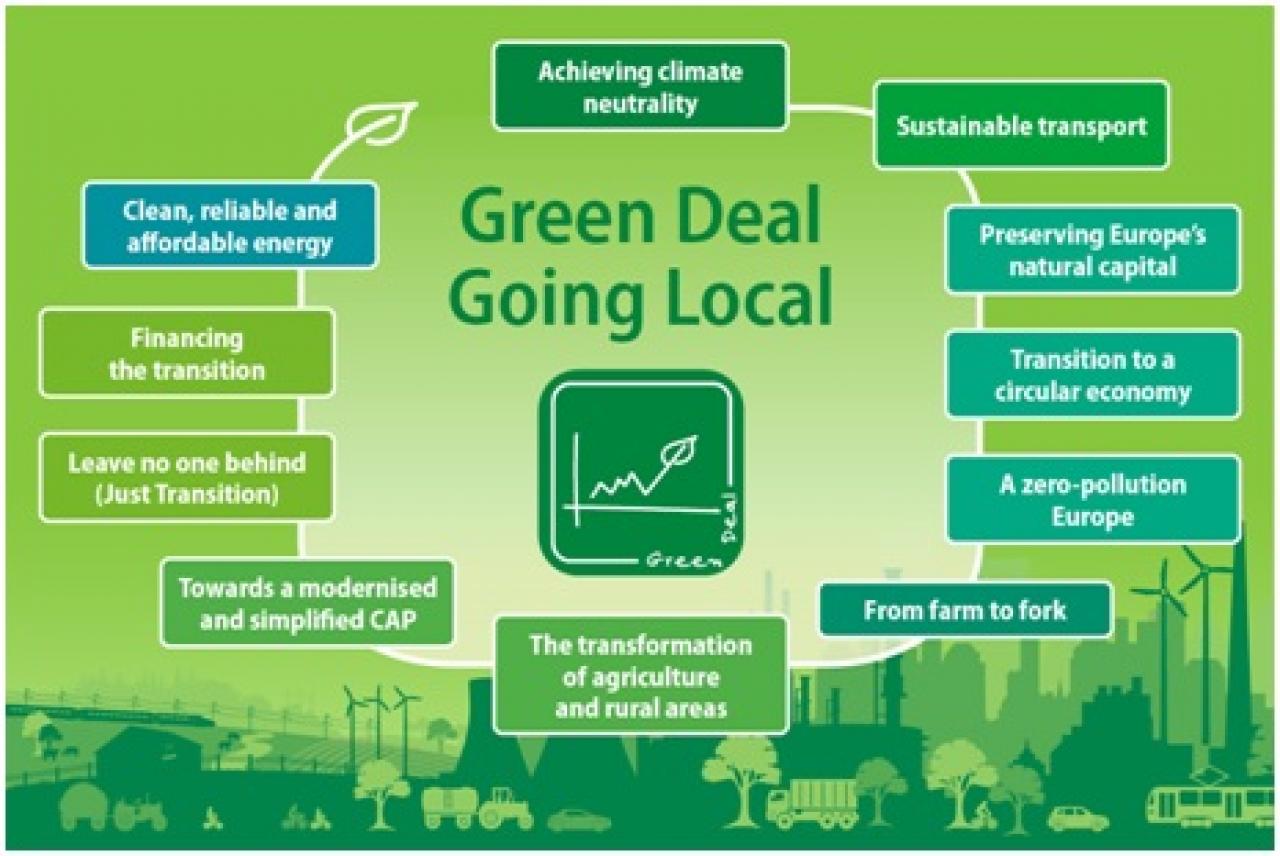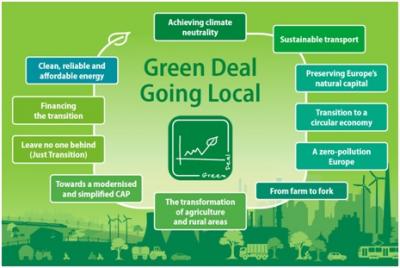
Small cities are often at a higher risk for the negative impacts of global trends that lead to economic downturns. At the same time, they are the places where a significant percentage of the population of the European Union live and work. So how can we address development problems and opportunities at the local level through contextualization of global consequences and locally available resources? How can we develop resilient local governments in an age when the world is faced with a global pandemic and some cities are facing economic crisis? According to the principles of Local Economic Development (LED), local development should be approached strategically and inclusively, and challenging decisions should be guided by sustainability goals.
This article is a follow-up to a Masterclass in Local economic development organised by the iPlace Project, a network of 10 small cities who examine opportunities for new local development and aim to find niches which will create potential for future economic growth.
Key LED principles
Local Economic Development (LED) should focus on the potential of specific cities and regions, identifying challenges and needs of local stakeholders to ensure the local community reaches its full potential. LED initiatives should have an impact on the economic viability of the entire city and the region, not just on one particular sector of the local economy.
Economic development is often thought of as a ‘marketing activity’ by the city, but the role and responsibilities of cities are broader and often strategic. Elements such as business retention and expansion, attracting investment , strategic alliances and partnerships, entrepreneurship and workforce development, supporting innovation, city-centre revitalization and community development are all key parts of today’s (city) economic development practitioner’s ‘toolkit’.
SMEs are one of the main drivers of job creation in medium and small sized cities. The OECD 2019. report states that they account for about 99% of all businesses, generating about 60% of employment. Therefore, Business retention and expansion (BRE) and Investment attraction are two main foundations of effective local economic development. The role of cities is to facilitate investment by promoting what the local area and the surrounding region offers in a strategic manner, but to also prioritize local infrastructure investment through an informed and complementary investment approach to destination economic development management.
To promote business retention and expansion (BRE), practitioners should focus on location criteria such as business-specific infrastructures, business-specific costs, general information and support, and the establishment of possibilities for cooperation. To ensure the viability of a small city, BRE programmes aim at retaining business in the community, providing support to those looking to expand and grow at their current location, and creating a stronger business climate that would increase the competitiveness of existing companies. Successful cities approach these elements in a strategic manner by starting the process with a participative and qualitative local assessment, using identifying instruments that would resolve challenges and provide solutions to local businesses as well as attract investment.
Depending on the city context and the main economic sector, almost all cities provide some sort of Business Technical Assistance (incubators, accelerators, mentorship programmes, access to capital, business training etc.). As an example of good practice, Gabrovo Municipality offers training through its 11 Vocational Education Centres, which directly contribute to its local manufacturing industries. In addition, the municipality is in process of developing an Innovation centre that will focus on local talent development and further attract entrepreneurs to the city. This is a great example of how to provide business technical assistance, attract investment and provide support for a local entrepreneurial ecosystem.

Creating vibrant communities where people not only can, but want to live and work can be quite a challenging task. A good example of city centre revitalization is a small Italian city, Grosseto, which approached its city centre revitalisation by creating a procedure for temporary use of empty shops encouraging these spaces to be taken up by ‘pop-up’ shops on a 3 to 6 month short-term let. This initiative led to 21 shops being given a new purpose and improving the vitality of the centre area.

Resilience
OECD defines resilient cities as cities that have the ability to absorb, recover and prepare for future shocks (economic, environmental, social and institutional). For small cities, diversification of sectors supporting the local economy is a key to resilience in economic downturns. Dubrovnik, a city that has a very strong mono-economy based on tourism, is a good example of how small cities are more vulnerable and exposed to severe economic impacts when tourism was nearly cut off during the current pandemic.
Fostering resilience is very complex and focused on long-term change, and should be created in a participatory manner involving local stakeholders representing multiple sectors, with a holistic approach focused on the local community and economy.
Strengthening resilience in small cities can be approached through three key aspects:
– Cohesive and engaged communities – creation of a collective identity and mutual support, street network connectivity, availability of effective and reliable ICT infrastructure,
– Fostering economic development through specific support – tailor made support after a citywide in-depth economic analysis, aiming at optimising conditions for competitiveness but staying in line with the local economic strategy,
– Supporting innovation through skills and talent – creating and supporting conditions for innovative investment, attracting and retaining talent as key focus.
New trends in Local Economic Development
With the main goal of retaining existing businesses and enhancing local economic development, three different aspects have been recognized as major trends affecting the economic future in Europe:
– change in workforce;
– technology;
– future Green Economy.
Each of these shed light on the future of work and business and should be considered when developing new business models and stimulating business environments. What is the role of cities in relation to new trends which have arisen in recent times, supported by European policies and good practice examples?
In relation to changes in labour market habits and expanded space for employment flexibility, cities need to encourage the formation of an institutional framework that allows different forms of work such as employee sharing, job sharing, freelance, work from alternative locations, collaborative work etc.
An example of such good practice, where authorities have responded quickly to changes and have stimulated the innovation ecosystem, is the case of the so-called ‘Digital nomads’, who appeared in the 2000s but became more common during the recent COVID-19 pandemic. New forms of work and wider flexibility of the labour market certainly bring many advantages, but cities, in the context of the quality of life of their citizens and visitors, must also consider work protection that guarantees a certain level of employment security. In the context of the benefits that flexibility in work brings for the local economy, cities could provide incentives for employers and develop further supportive entrepreneurial infrastructure.
The digital transformation of businesses and new technologies that provide more efficient resource management and decision-making based on big data are becoming an imperative for sustainable economic development. The role that cities have in ensuring successful transition to the digital age and prosperous local economic development is comprehensive.
By developing the basic IT infrastructure, hardware and software, promoting the use of digital technologies and ensuring the use of new technologies and big data internally, local city governance would use the opportunity for digital transformation to reset the economy, create jobs, boost GDP and build resilience.
Transitions to a circular economy and green forms of business are among the key elements of sustainable development which are integral to the cooperation among the public, the private and civil sector. Green economy has the potential to ensure resilience of local communities, primarily in the context of climate change. It opens new opportunities for disruption in the business and manufacturing sector while concentrating on the local resources and opportunities to involve the local community in the development of the local economy. (More information regarding How to accelerate cities’ transition to the circular economy by Eleni Feleki, Lead Expert of URGE:Building circular cities network, is available here).

Conclusion
To build a strong and resilient local economy, good practice shows that an integrated approach towards LED development is crucial for a long-term sustainable development. It should be a collaborative process to understand the local economy and conduct an analysis of the area’s strengths, challenges, opportunities and threats.
The following 4 aspects – Community assets and resources, Community capabilities, Business Climate and Quality of life should be a key focus of the initial city analysis towards the development of the Economic Development Planning document.
URBACT offers a set of tools and resources for integrated and participative work, while iPlace network is developing a self-assessment tool for practitioners and stakeholders in the local economic development of small cities. This tool measures how a city is performing compared to its peers by considering selected areas and indicating its comparative competitive advantage.
Cities have an important role in stimulating business environments in line with new trends and principles of LED through the following three areas– Capacity-building and providing support for business model development; Improving the regulatory framework, either in the form of additional regulation or deregulation; Improving opportunities for financing innovation, business transformation and transition to a green economy.
Written by Alisa Aliti Vlasic

